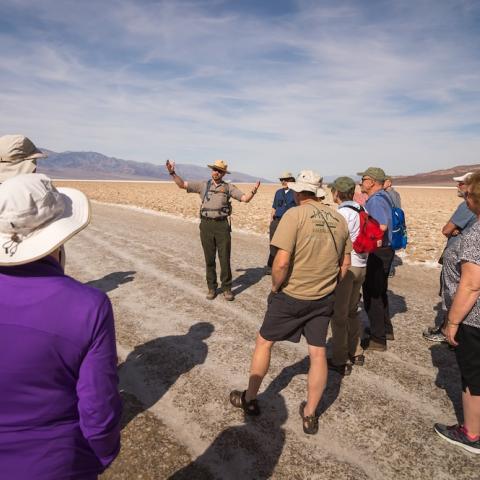
Vehicle tracks on Eureka Dunes / NPS
At some point in late December or early January, a person or a group of people drove vehicles over dunefields in the Eureka Valley section of Death Valley National Park, and in doing so, they damaged rare plants listed as threatened under the Endangered Species Act. The National Park Service needs help identifying who it was.
An NPS biologist documented damage to Eureka dunegrass (Swallenia alexandrae), a plant species that only grows on sand dunes in Eureka Valley. Eureka dunegrass is classified as a threatened species by the U.S. Fish and Wildlife Service.
At least one Eureka dunegrass plant was directly damaged by vehicle tracks, while eight additional plants were likely affected by root damage due to their proximity to the tracks. Over two miles of vehicle tracks were left on the dunes, suggesting that further damage to seeds and other rare plants is likely.
“I urge the public to come forward with any information that could help identify those responsible for driving on Eureka Dunes,” said Superintendent Mike Reynolds. “I’m saddened that someone would disregard the survival of a rare species for a few minutes of joyriding. There are multiple areas on BLM land nearby, such as Dumont Dunes, which are set aside for this type of recreation but the sensitive dune systems in the National Park are set aside to be protected.”
Eureka Valley also contains cryptobiotic soil, a crucial and extremely fragile part of the desert ecosystem. It's essentially a living crust composed of cyanobacteria, mosses, and fungi that trap moisture and provide a foothold for life in arid and semi-arid places. It also grows very slowly. It can take decades or centuries for cryptobiotic soil to recover from being even stepped on, let alone driven over.
In addition to the documented damage to Eureka dunegrass, the vehicle tracks may have harmed five other rare plant species:
- Eureka Dunes evening-primrose (Oenothera californica ssp. eurekensis)
- Shining milk vetch (Astragalus lentiginosus var. micans)
- Gravel milk vetch (Astragalus sabulonum)
- Hillman’s silverscale (Atriplex argentea var. hillmanii)
- Wheeler’s chaetadelpha (Chaetadelpha wheeleri)
Eureka Dunes evening-primrose only lives on dunes in Eureka Valley. It was removed from the endangered species list in 2018 due to reduced threat of damage from offroad driving. Shining milkvetch only lives on dunes in Eureka and Panamint Valleys.
Eureka Dunes are 680 feet tall, making them the tallest dunes in California. The dune field is about three miles long by one mile wide. Eureka Dunes is designated as a National Natural Landmark.
Information from visitors is often very helpful to investigators. You don't have to tell us who you are, but please tell us what you know:
- Call the NPS Tip Line 888-653-0009
- Email [email protected]
- Online form go.nps.gov/SubmitATip.




 Support Essential Coverage of Essential Places
Support Essential Coverage of Essential Places






